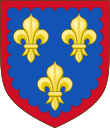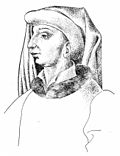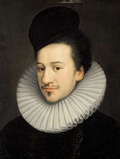Duke of Berry
| Dukedom of Berry | |
|---|---|
 Arms of Berry after 1376 | |
| Creation date | October 1360 |
| Created by | John II of France |
| Peerage | Peerage of France |
| First holder | John of Berry |
| Last holder | Charles Ferdinand of Artois |
| Status | Extinct |
| Extinction date | 14 February 1820 |
Duke of Berry (French: Duc de Berry) or Duchess of Berry (French: Duchesse de Berry) was a title in the Peerage of France. The Duchy of Berry, centred on Bourges, was originally created as an appanage for junior members of the French royal family and was frequently granted to female royals. The style Duke of Berry was later granted by several Bourbon monarchs to their grandsons. The last official Duke of Berry was Charles Ferdinand of Artois, son of Charles X. The title Duke of Berry is currently being claimed through its usage as a courtesy title by Prince Alphonse de Bourbon, son of Prince Louis, Duke of Anjou, the Legitimist claimant to the French Throne.[citation needed]
House of Valois (1360-1505)[edit]
On October 1360, King John II created the peerage-duchy of Berry as an appanage for his third-born son, John of Poitiers, perhaps on the occasion of his marriage with Joan of Armagnac.[1] Upon his death in 1416, John of Poitiers was succeeded as Duke of Berry by his grandnephew John, Dauphin of France (having been predeceased in 1397 by his only son who survived into adulthood, John, Count of Montpensier).[2] After Dauphin John's death in 1417, the appanage passed to his younger brother the Dauphin Charles. The Dauphin subsequently moved his court to Berry's capital of Bourges to escape the advancing English during the Hundred Years’ War.[3] When the Dauphin ascended to the throne as Charles VII, Berry returned to the royal domain.
In 1461, Louis XI granted Berry to his younger brother, Charles. Charles maintained a rivalry with his brother and joined the League of the Public Weal, an anti-royal alliance of French magantes led by the Count of Charolais. After a short war against Louis XI which was concluded with the Treaty of Conflans in 1465, Charles gained the Duchy of Normandy (which he then exchanged for the Duchy of Guyenne in 1469). Charles died without legitimate issue in 1472 due to syphilis, although some believed he was a victim of poisoning.[4] With no male heir, the title reverted to the Crown once again.
In 1498, Louis XII granted Berry to his former wife Joan of France, daughter of Louis XI, as compensation for their marriage's annulment.[5] She was the first suo jure Duchess, and after her death without issue Berry returned to the Crown.
| Duke | Birth | Tenure | Death | Marriage(s) Issue | |
|---|---|---|---|---|---|
 John of France Other titles |

|
30 November 1340 Château de Vincennes Son of John II of France and Bonne of Luxembourg |
October 1360 – 15 June 1416 |
15 June 1416 Paris Died by natural causes (aged 75) |
(1) Joan of Armagnac (m. 1360; d. 1387) 5 children (2) Joan II of Auvergne (m. 1389; wid. 1416) Childless |
 John of France Other titles |
 |
31 August 1398 Paris Son of Charles VI of France and Isabeau of Bavaria |
1416 – 5 April 1417 |
5 April 1417 Compiègne Died by natural causes (aged 18) |
Jacqueline of Hainaut (m. 1415; wid. 1417) Childless |
 Charles of France Other titles |
 |
22 February 1403 Paris Son of Charles VI of France and Isabeau of Bavaria |
1417 – 1422 (merged with Crown) |
22 July 1461 Mehun-sur-Yèvre Died by natural causes (aged 58) |
Marie of Anjou (m. 1422; wid. 1461) 14 children |
 Charles of France Other titles |

|
26 December 1446 Château de Tours Son of Charles VII of France and Marie of Anjou |
November 1461 – 24 May 1472 |
24 May 1472 Bordeaux Died by syphilis (aged 25) |
Never married |
 Joan of France |

|
23 April 1464 Nogent-le-Roi Daughter of Louis XI of France and Charlotte of Savoy |
7 April 1498 – 4 February 1505 |
4 February 1505 Bourges, Berry Died by natural causes (aged 40) |
Louis II, Duke of Orléans (then Louis XII) (m. 1476; ann. 1498) Childless |
House of Valois-Angoulême (1527-1601)[edit]
In 1527, King Francis I granted his sister Marguerite the duchy of Berry, probably on the occasion of her marriage to Henry II of Navarre.[6] After her death without male issue in 1549, Berry reverted to the Crown.
In 1550, King Henry II granted Berry to his sister Margaret of Valois for life.[7] After the death of Margaret of Valois in 1574, her nephew King Henry III granted Berry and the County of La Marche to his sister-in-law and Queen dowager of France Elisabeth of Austria.[8] However, in 1577, as a consequence of the Peace of Monsieur, Elisabeth of Austria was forced by King Henry III to exchange Berry and La Marche (which then became part of the expanded appanage of his brother Francis, Duke of Anjou) for the duchies of Auvergne and Bourbon.[9] After Francis, Duke of Anjou's death in 1584, Berry and his other appanages again returned to the Crown.
In 1589, King Henry IV granted Berry to King Henry III's widow Louise of Lorraine for her lifetime.
| Duke | Birth | Tenure | Death | Marriage(s) Issue | |
|---|---|---|---|---|---|
 Margaret of Navarre Other titles |

|
11 April 1492 Château d'Angoulême Daughter of Charles of Orléans and Louise of Savoy |
24 January 1527 – 21 December 1549 |
21 December 1549 Odos, Navarre Died by natural causes (aged 57) |
(1) Charles IV of Alençon (m. 1509; d. 1525) Childless (2) Henry II of Navarre (m. 1527; wid. 1549) 1 child |
 Margaret of France Other titles |

|
5 June 1523 Saint-Germain-en-Laye Daughter of Francis I and Claude of Brittany |
29 April 1550 – 15 September 1574 |
15 September 1574 Turin, Savoy Died by natural causes (aged 51) |
Emmanuel Philibert of Savoy (m. 1559; wid. 1574) 1 child |
 Elisabeth of Austria Other titles |

|
5 July 1554 Vienna, Austria Daughter of Emperor Maximilian II and Mary of Austria |
21 November 1575 – 25 September 1577 (Title forfeited) |
22 January 1592 Vienna, Austria Died by pleurisy (aged 37) |
Charles IX of France (m. 1570; d. 1574) 1 child |
 Francis of France Other titles |

|
18 March 1555 Château de Fontainebleau Son of Henry II and Catherine de' Medici |
25 September 1577 – 10 June 1584 |
10 June 1584 Château-Thierry Died by malaria (aged 29) |
Never married |
 Louise of Lorraine |

|
30 April 1553 Nomeny, Barrois Daughter of Nicolas, Duke of Mercœur and Margaret of Egmont |
August 1589 – 29 January 1601 |
29 January 1601 Moulins, Bourbonnais Died by natural causes (aged 47) |
Henry III of France (m. 1575; d. 1589) Childless |
House of Bourbon (1686-1820)[edit]
In 1686, King Louis XIV granted the style Duke of Berry to his third grandson Charles who continued to use it as his primary title until his death in 1714, despite never gaining the appanage of Berry.[10] In 1754, King Louis XV styled his newborn grandson Louis-Auguste as Duke of Berry until his ascension as Dauphin of France in 1765, after his father's death.
In 1778, King Louis XVI re-established the Duchy of Berry as an appanage for his newborn nephew, Charles Ferdinand of Artois, who was killed in 1820 by Louis Pierre Louvel, a Bonapartist.
| Duke | Birth | Tenure | Death | Marriage(s) Issue | |
|---|---|---|---|---|---|
 Charles of France Other titles |

|
31 July 1686 Versailles Son of Louis, Dauphin of France and Maria Anna of Bavaria |
31 July 1686 – 5 May 1714 |
5 May 1714 Versailles Died in hunting accident (aged 27) |
Louise Élisabeth d'Orléans (m. 1710; wid. 1714) Childless |
 Louis-Auguste of France (then Louis XVI) |

|
23 August 1754 Versailles Son of Louis, Dauphin of France and Maria Josepha of Saxony |
23 August 1754 – 20 December 1765 (Became Dauphin) |
21 January 1793 Place de la Révolution, Paris Executed for treason (aged 38) |
Marie Antoinette of Austria (m. 1770; wid. 1793) 4 children |
 Charles Ferdinand of Artois |

|
24 January 1778 Versailles Son of Charles of Artois and Maria Theresa of Savoy |
24 January 1778 – 14 February 1820 |
14 February 1820 Outside Paris Opera Murdered by Louis Pierre Louvel (aged 42) |
Marie-Caroline of Sicily (m. 1816; wid. 1820) 2 children |
See also[edit]
References[edit]
- ^ Plumley, Yolanda (2003). Cambridge University Press (ed.). Ars subtilior and the Patronage of French Princes. pp. 145–146.
{{cite book}}:|work=ignored (help) - ^ Autrand, Françoise (2000). Fayard (ed.). Jean de Berry: L'art et le pouvoir. p. 263.
- ^ Richard Vaughan, John the Fearless: The Growth of Burgundian Power, Vol. 2, (Boydell Press, 2005), 263.
- ^ Moisand, Constant (1847). Imprimerie de Moisand (ed.). Histoire du siége de Beauvais en 1472.
- ^ "St. Joan of Valois". Catholic.org. Retrieved: 26 October 2014.
- ^ Michaud-Fréjaville, Françoise (27 June 2006). "L'œuvre et la vie de Marguerite de Navarre, un plaidoyer pour la tolérance". m2navarre.net (in French).
- ^ Marshall, Rosalind K. (2003). Scottish Queens, 1034-1714. Tuckwell Press. p. 10o.
- ^ Nadaud, Joseph (1878). Société historique et archéologique du Limousin (ed.). Nobiliaire du diocèse et de la généralité de Limoges. Vol. III. p. 182.
- ^ Knecht, Robert J. (2002). Osprey Publishing (ed.). The French Religious Wars 1562-98. p. 53.
- ^ See the Letters patent: Louis, par la grâce de Dieu, roy de France et de Navarre, à tous présens et à venir, SALUT. (…) Notre très-cher et très-amé petit-fils Charles, fils de France, a dignement répondu à nos espérance (…) Pour ces causes et autres à ce Nous mouvans, de l’avis de notre conseil, Nous avons donné, octroyé et délaissé, et par ces présentes signées de notre main, donnons, octroyons et delaissons à notredit petit-fils Charles, fils de France, et à ses enfans mâles descendans de lui en loyal mariage, pour leur appanage et entretenement, selon la nature des appanages de la Maison de France et les lois de notre royaume, les duchés d’Alençon et d’Angoulême, le comté de Ponthieu et les châtellenies de Coignac et de Merpins, réunis à notre couronne par le décès de notre cousine Elisabeth d’Orléans, duchesse de Guise, ensemble les terres et seigneuries de Noyelles, Hiermont, Coutteville et le Mesnil, par Nous acquises par contrat passé entre les commissaires par Nous nommez, et Marie d’Orléans, duchesse de Nemours, le 16 Decembre 1706, en échange de la baronie, terre et seigneuries de Parthenay (…).
